The dollar took a breather on Wednesday as investors waited to see if the U.S. Federal Reserve will signal any acceleration in the pace of future rate increases to deal with an expected ramp-up in fiscal spending under President-elect Donald Trump.
In its policy meeting ending later in the day, the Federal Open Market Committee (FOMC) is seen as all but certain to raise its interest rate target by 0.25 percentage point to 0.50-0.75 percent. The decision will be announced at 1900 GMT.
It would be just the Fed’s second rate hike since the financial crisis in 2007-08, following last December’s tightening.
“The markets think a rate hike is a certainty so the focus is on the outlook for next year. I think they will maintain their previous projections to raise rates twice next year but if they turn more hawkish, the dollar will test its upside again,” said Shinichiro Kadota, chief FX strategist at Barclays.
The dollar index, which tracks the U.S. unit against a basket of six major currencies, edged down to 101.00, having slipped from this week’s high of 101.78 touched early on Monday.
The euro inched higher to $1.0637, pulling further away from Monday’s one-week low of $1.0525.
Against the yen, the dollar was slightly higher at 115.25 yen, but remained well below Monday’s 10-month peak of 116.12 yen.
Some investors were eager to take profits from the dollar’s massive rally of about 10 percent against the yen since the Nov 8 U.S. election.
Expectations that Trump will cut taxes, boost fiscal spending and raise U.S. growth over the near-term lifted U.S. bond yields and stock prices, making the dollar more attractive.
On Monday, the benchmark U.S. 10-year yield touched more than two-year highs above 2.50 percent, and the 30-year U.S. Treasury yield climbed to around a 17-month peak.
“If Treasury yields could correct lower after the FOMC outcome, that means the yen could appreciate again,” said Yutaka Miura, a senior technical analyst at Mizuho Securities.
“Until then, the pair is range-bound in the 115-level,” he said.
Although many investors had long thought the Fed will raise rates very slowly and cautiously, especially under dovish Chair Janet Yellen, Trump’s surprise election victory last month has drastically shaken up that assumption.
The two-year U.S. debt yield rose to a 6 1/2-year high on Tuesday, and U.S. money market futures are pricing in almost two rate hikes next year.
That marks a sea change from before the election, when markets were not fully pricing in even one rate hike in 2017.
Commodity-linked currencies were supported by strong rises in oil prices after OPEC and some of its rivals reached their first deal since 2001 to jointly reduce output to tackle global oversupply.
The Australian dollar traded at $0.7489, having hit a near one-month high of $0.7524 on Tuesday.
The Aussie was also not far from its March peak of 86.66 yen, a break of which could open a way for a test of above 90 yen touched last year.
The Canadian dollar stood at C$1.3133 per U.S. dollar, after having risen to as high as C$1.3102 to the dollar on Tuesday, an eight-week high.
The biggest winner in the past few sessions from rallying oil prices was the Russian rouble, which rose 5.4 percent over the past week against the dollar to hit a 16-1/2-month high.
The Russian currency is the best performing currency since Trump’s upset.
Source: Reuters
